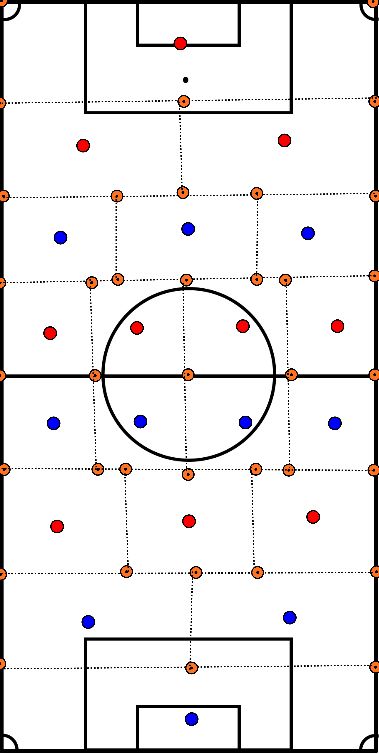Soccer drills for technique positional play
- Short pass man on the right, getting inside the ball.
- Short handball, moving around the declarer.
- Tight short pass to striker.
- Handball to right player.
- Tight ball between the lines in the deep to the outfield player.
- Run on time!
- Do not be offside.
- Tight pass to the centre.
- Finish!
- No touch is an extra point.
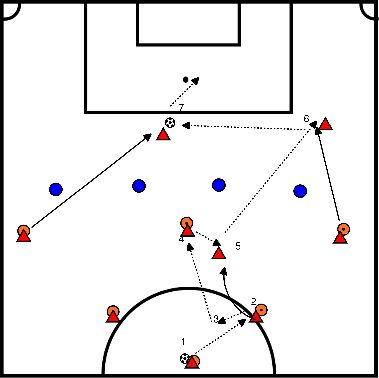
- Trainer kicks depth ball.
- K decides whether to come out or defend goal.
- Attacker tries to take ball away and score on goal.
- If goalkeeper has ball, 2 on off via O.
- Attacker takes ball with him and may not finish in 1 time.
- Line up twice (2 trainers).
- Duration 15 minutes.
- Upgrade 1 :
- Trainer chooses high ball.
- Upgrade 2 :
- 2 attackers instead of 1 (2 VS 2), attacker 2 may only join when goalkeeper can play.
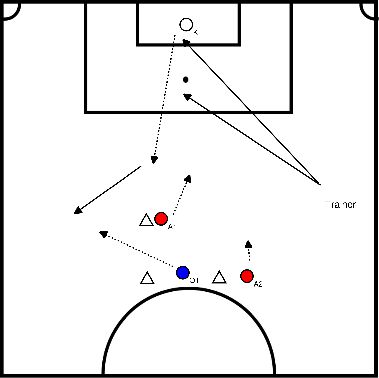
- We play 2 against 1 (in each mini goal a defender - 3 mini goals) .
- On 2 mini goals stands a defender (yellow jacket) .
- Orange jacket plays into the 2 attackers and defends the third goal.
- Defenders can move freely and defend another mini goal if necessary.
- Attackers may only score inside the defined zone (yellow).
- So this is an exercise of how to move without the ball (both A and V) , sliding through A becomes V .
- Orange jacket stays in same position for a few minutes (intensive).
- Coaching on free running, moving without the ball.
- Make actions ok!
- Passing even better!
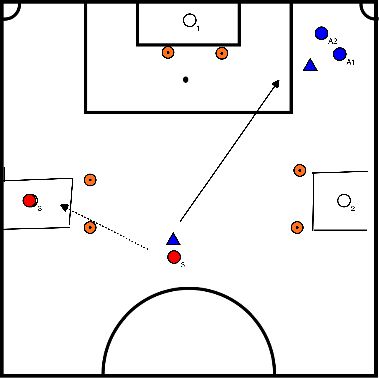
- Ordinary rules of the game (match alike)
- Check that what has been learnt is understood and applied in a game
- Scoring in the small goal must be done with the foot. = 1 point
- Scoring in the big goal with the head = 2 points
- Has the objective been achieved?
- To see the relationship between the solutions/possibilities offered in the previous exercise forms and the party form (competition)
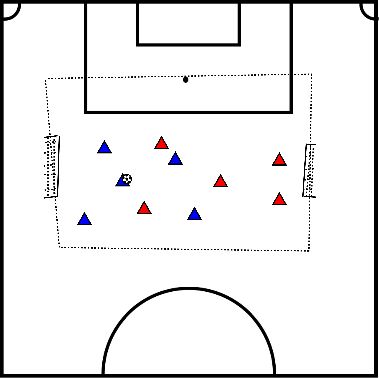
Team task:
Structure
Purpose:
Improve assumption to "move" opponent
Organisation:
- Positioning game 3/4x1 in square box of 6x6.
- pawn in the middle, team ball-possession must shoot this pawn for points, defender must prevent this.
- Each player in team ball-possession is on one side of the square.
- A player may only defend by intercepting a pass on a pawn.
- Match/fun element can be reinforced by agreeing that the person with the most points has won after 5 minutes, the rest must for example do 10 push-ups or sprints.
- Can be made more difficult by the fact that attacking party has to score in 10 passes.
Coaching:
Direction in assumption to "move" opponent, freeing up space to play towards pawn.
1.5 metres:
- Because the defender is only allowed to intercept passes, there are no duels.
- Furthermore, perimeter ensures that players in team ball-possession do not come closer than 1.5 metres.
- the shape also invites players to keep the pitch as large as possible.
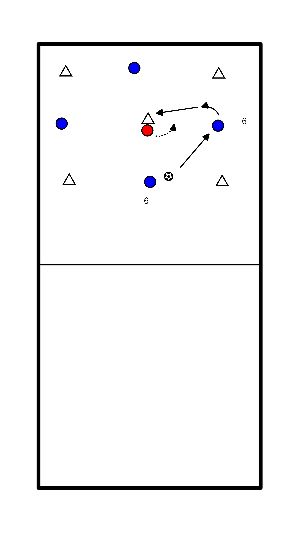
Team task:
Building up
Purpose:
Improve deep play at the right moment.
Organisation:
- Field of e.g. 30x30,
- Divided into 16 compartments.
- On the 2 sides
- 2 goals.
- 2 teams of 6.
- 2 players per team are divided over 4 boxes at the back,
- 4 players all have their own square.
- There is a box with defenders between the two parts of the team.
- Four must reach the duos, the duos can score in goals (see picture).
- More difficult:
- A maximum of 10 passes.
- See picture.
- 1.5 metres: boxes prevent players from duelling with each other or getting close to each other.
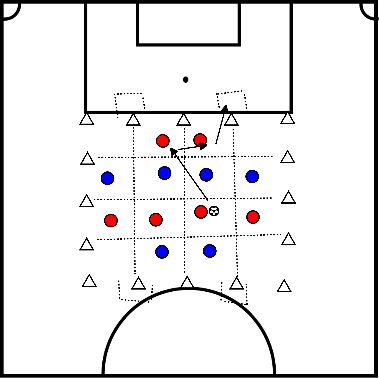
- Upper exercise:
- No. 2/5 has the ball.
- One of these two starts with the ball and plays in number 6.
- Number 6 bounces the ball back to number 2, number 10 in the meantime, together with number 7, make their move.
- Number two plays in number 10.
- Number 10 plays the ball deep on number 2.
- Number 2 takes the ball at the foot.
- Number 7 and 9 position themselves in front of the goal while number 2 brings the ball forward.
- Bottom exercise:
- Number 6 and 8 take turns playing the ball to number 10.
- Number 8, for example, plays to number 10.
- Number 10 bounces the ball to number 6.
- Number 6 plays the ball closely in front of number 2.
- Number 2 bounces the ball to number 7, which has entered for action as soon as number two starts running.
- Number plays the ball and the depth for number two.
- Number 7, 9, 11 make their run action towards the goal.
- Number 10 stands on the 16-metre line in front of the falling ball.
Switching positions:
- Number 6 8 and 10 switch positions. The player inserting the ball lands on the position of the player playing the ball deep for No. 2 or No. 5.
- The player playing the ball deep substitutes number 10.
- No. 10 stands behind one of the two with the least number of people.
- Numbers 7 and 2 alternate positions.
- Numbers 5 and 11 alternate positions.
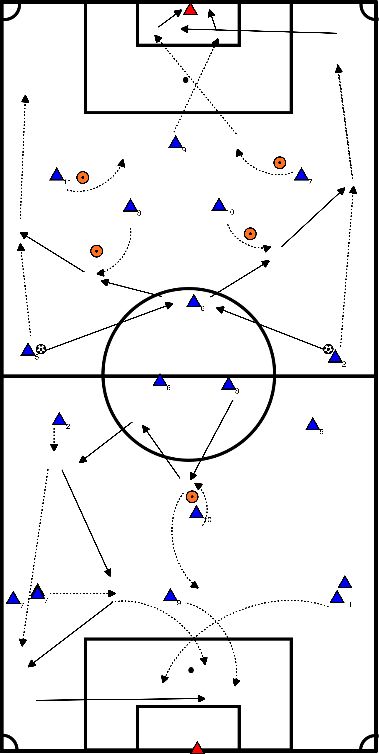
- Defence to attack in a 1-4-4-2.
- The running forms of the attack and defence are important here.
- Form two of the two where the focus is on the outfielder 7/8 creates space for the 2/5 .
- Here the six of the bb game is used to give the through ball.
- The exercise can be done without or with resistance.
- In the case of the ball owning party it is important that they do not play the ball directly on the 7/8 but first move the ball for some time between 3->4 4->5, where five gets up high as soon as the ball goes from two to three.
- When five receives the ball do not play directly to the eight but first back to the four.
- From four to three and from three to two.
- Allow the defence to pass the right running lines at the right time before they play the ball to the 7/8.
- As soon as the ball goes from the two to the seven, pay attention to the correct running lines of the seven.
- Creating space for the two is done by letting the seven get into the ball and bouncing the ball to the six.
- After bouncing from the two to the seven the two has to make a run in the deep.
- The seven bounces the ball onto the six that comes under the ball.
- The six then plays the ball deep on the two with the nine running to the first post, the eleven behind the nine and the eight around the second post in an oblique line behind the eleven and nine.
- Ten comes on the sixteen-metre line and the seven diagonally behind the two.
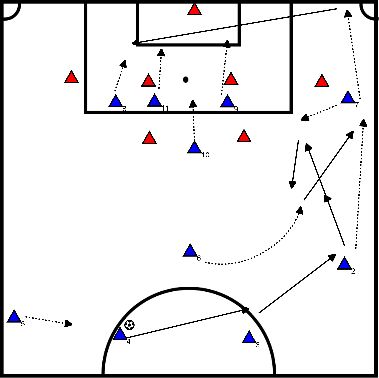
- The defenders (formation 1-2-2) try to prevent the attackers from scoring, by making the space as small as possible and conquering or blocking the ball at all costs.
- The defenders help each other by keeping the distance between them as small as possible.
- The attackers (formation 4-2) try to make the field as large as possible in order to score a goal
- After conquering the ball, the defenders can try to score in a small goal
- The attackers can score in a big goal with a goalkeeper
- When the ball goes out of the field, it is kicked back in where it went out.
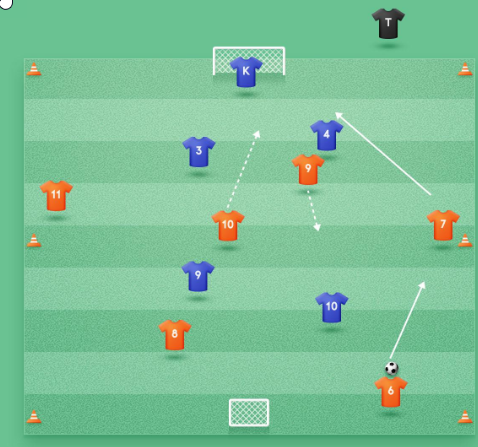
In King Football, the players learn to pass well.
- 2 teams
- Per team 1 King
- 1 ball per team. (variation 1 ball if a game is played)
- The teams move in the field in a square.
- The intention is that the ball is played over 3 times within your own team and then shot to the King.
- When the King takes it, there is a point for that team.
- First, they practise within the team and then they play against each other.
- When the ball is taken away, it has to be counted again.
2 teams
- The players have to play football 4 against 2 and must have replayed at least 3 times in the attack and a maximum of 10 times before scoring.
- When a ball is taken off/ touched/ crosses the line or a score is scored, there must be a switch between attacking and defending.
- When there is no overplay, no scoring is allowed.
- The idea is to be able to play a game in corona time.
- The idea comes from a table soccer game
- Each player has his own space they are not allowed to leave.
- By passing, the ball can be brought to the other player
- Defense is allowed as long as it remains in his/her own discipline.
- The field can be adjusted to the number of players
Further goals:
- Passing
- Positioning game
- Shooting Distance
- The exercise can be made more difficult by making the game faster
- By only hitting the ball 2 or 3 times and playing quickly
- After all, during a match you don't have that much time either
